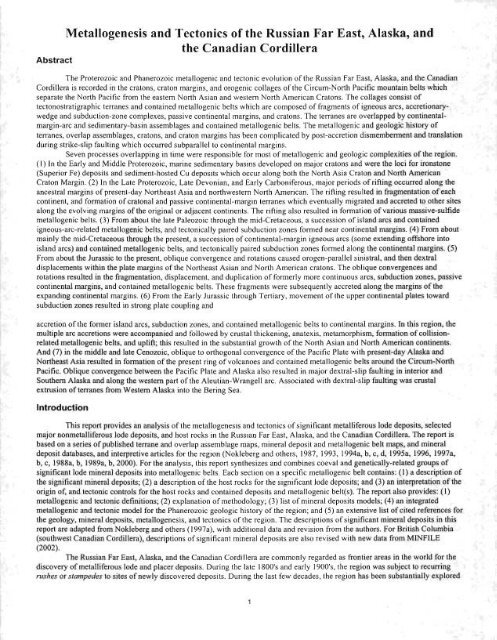Metallogenesis and Tectonics of the Russian Far East, Alaska, and ...
Metallogenesis and Tectonics of the Russian Far East, Alaska, and ...
Metallogenesis and Tectonics of the Russian Far East, Alaska, and ...
Create successful ePaper yourself
Turn your PDF publications into a flip-book with our unique Google optimized e-Paper software.
<strong>Metallogenesis</strong> <strong>and</strong> <strong>Tectonics</strong> <strong>of</strong> <strong>the</strong> <strong>Russian</strong> <strong>Far</strong> <strong>East</strong>, <strong>Alaska</strong>, <strong>and</strong><br />
<strong>the</strong> Canadian Cordillera<br />
Abstract<br />
The Proterozoic <strong>and</strong> Phanerozoic metallogenic <strong>and</strong> tectonic evolution <strong>of</strong> <strong>the</strong> <strong>Russian</strong> <strong>Far</strong> <strong>East</strong>. <strong>Alaska</strong>, <strong>and</strong> <strong>the</strong> Canadian<br />
Cordillera is recorded in <strong>the</strong> cratons, craton margins, <strong>and</strong> orogenic collages <strong>of</strong> <strong>the</strong> Circum-North Pacific mountain belts which<br />
separate <strong>the</strong> North Pacific from <strong>the</strong> eastern North Asian <strong>and</strong> western North American Cratons. The collages consist <strong>of</strong><br />
tectonostratigraphic terranes <strong>and</strong> contained metallogenic belts which are composed <strong>of</strong> fragments <strong>of</strong> igneous arcs, accretionary-<br />
wedge <strong>and</strong> subduction-zone complexes, passive continental margins, <strong>and</strong> cratons. The terranes are overlapped by continental-<br />
margin-arc <strong>and</strong> sedimentary-basin assemblages <strong>and</strong> contained metallogenic belts. The metallogenic <strong>and</strong> geologic history <strong>of</strong><br />
terranes, overlap assemblages, cratons, <strong>and</strong> craton margins has been complicated by post-accretion dismemberment <strong>and</strong> translation<br />
during strike-slip faulting which occurred subparallel to continental margins.<br />
Seven processes overlapping in time were responsible for most <strong>of</strong> metallogenic <strong>and</strong> geologic complexities <strong>of</strong> <strong>the</strong> region.<br />
(1) In <strong>the</strong> Early <strong>and</strong> Middle Proterozoic, marine sedimentary basins developed on major cratons <strong>and</strong> were <strong>the</strong> loci for ironstone<br />
(Superior Fe) deposits <strong>and</strong> sediment-hosted Cu deposits which occur along both <strong>the</strong> North Asia Craton <strong>and</strong> North American<br />
Craton Margin. (2) In <strong>the</strong> Late Proterozoic, Late Devonian, <strong>and</strong> Early Carboniferous, major periods <strong>of</strong> rifting occurred along <strong>the</strong><br />
ancestral margins <strong>of</strong> present-day Nor<strong>the</strong>ast Asia <strong>and</strong> northwestern North American. The rifling resulted in fragmentation <strong>of</strong> each<br />
continent, <strong>and</strong> formation <strong>of</strong> cratonal <strong>and</strong> passive continental-margin terranes which eventually migrated <strong>and</strong> accreted to o<strong>the</strong>r sites<br />
along <strong>the</strong> evolving margins <strong>of</strong> <strong>the</strong> original or adjacent continents. The rifting also resulted in formation <strong>of</strong> various massive-sulfide<br />
metallogenic belts. (3) From about <strong>the</strong> late Paleozoic through <strong>the</strong> mid-Cretaceous, a succession <strong>of</strong> isl<strong>and</strong> arcs <strong>and</strong> contained<br />
igneous-arc-related metallogenic belts, <strong>and</strong> tectonically paired subduction zones formed near continental margins. (4) From about<br />
mainly <strong>the</strong> mid-Cretaceous through <strong>the</strong> present, a succession <strong>of</strong> continental-margin igneous arcs (some extending <strong>of</strong>fshore into<br />
isl<strong>and</strong> arcs) <strong>and</strong> contained metallogenic belts, <strong>and</strong> tectonically paired subduction zones formed along <strong>the</strong> continental margins. (5)<br />
From about <strong>the</strong> Jurassic to <strong>the</strong> present, oblique convergence <strong>and</strong> rotations caused orogen-parallel sinistral, <strong>and</strong> <strong>the</strong>n dextral<br />
displacements within <strong>the</strong> plate margins <strong>of</strong> <strong>the</strong> Nor<strong>the</strong>ast Asian <strong>and</strong> North American cratons. The oblique convergences <strong>and</strong><br />
rotations resulted in <strong>the</strong> fragmentation, displacement, <strong>and</strong> duplication <strong>of</strong> formerly more continuous arcs, subduction zones, passive<br />
continental margins, <strong>and</strong> contained metallogenic belts. These fragments were subsequently accreted along <strong>the</strong> margins <strong>of</strong> <strong>the</strong><br />
exp<strong>and</strong>ing continental margins. (6) From <strong>the</strong> Early Jurassic through Tertiary, movement <strong>of</strong> <strong>the</strong> upper continental plates toward<br />
subduction zones resulted in strong plate coupling <strong>and</strong><br />
accretion <strong>of</strong> <strong>the</strong> former isl<strong>and</strong> arcs, subduction zones, <strong>and</strong> contained metallogenic belts to continental margins. In this region, <strong>the</strong><br />
multiple arc accretions were accompanied <strong>and</strong> followed by crustal thickening, anatexis, metamorphism, formation <strong>of</strong> collision-<br />
related metallogenic belts, <strong>and</strong> uplift; this resulted in <strong>the</strong> substantial growth <strong>of</strong> <strong>the</strong> North Asian <strong>and</strong> North American continents.<br />
And (7) in <strong>the</strong> middle <strong>and</strong> late Cenozoic, oblique to orthogonal convergence <strong>of</strong> <strong>the</strong> Pacific Plate with present-day <strong>Alaska</strong> <strong>and</strong><br />
Nor<strong>the</strong>ast Asia resulted in formation <strong>of</strong> <strong>the</strong> present ring <strong>of</strong> volcanoes <strong>and</strong> contained metallogenic belts around <strong>the</strong> Circum-North<br />
Pacific. Oblique convergence between <strong>the</strong> Pacific Plate <strong>and</strong> <strong>Alaska</strong> also resulted in major dextral-slip faulting in interior <strong>and</strong><br />
Sou<strong>the</strong>rn <strong>Alaska</strong> <strong>and</strong> along <strong>the</strong> western part <strong>of</strong> <strong>the</strong> Aleutian-Wrangell arc. Associated with dextral-slip faulting was crustal<br />
extrusion <strong>of</strong> terranes from Western <strong>Alaska</strong> into <strong>the</strong> Bering Sea.<br />
Introduction<br />
This report provides an analysis <strong>of</strong> <strong>the</strong> metallogenesis <strong>and</strong> tectonics <strong>of</strong> significant metalliferous lode deposits, selected<br />
major nonmetalliferous lode deposits, <strong>and</strong> host rocks in <strong>the</strong> <strong>Russian</strong> <strong>Far</strong> <strong>East</strong>, <strong>Alaska</strong>, <strong>and</strong> <strong>the</strong> Canadian Cordillera. The report is<br />
based on a series <strong>of</strong> published terrane <strong>and</strong> overlap assemblage maps, mineral deposit <strong>and</strong> metallogenic belt maps, <strong>and</strong> mineral<br />
deposit databases, <strong>and</strong> interpretive articles for <strong>the</strong> region (Nokleberg <strong>and</strong> o<strong>the</strong>rs, 1987, 1993, 1994a, b, c, d, 1995a, 1996, 1997a,<br />
b, c, 1988a, b, 1989a, b, 2000). For <strong>the</strong> analysis, this report syn<strong>the</strong>sizes <strong>and</strong> combines coeval <strong>and</strong> genetically-related groups <strong>of</strong><br />
significant lode mineral deposits into metallogenic belts. Each section on a specific metallogenic belt contains: (1) a description <strong>of</strong><br />
<strong>the</strong> significant mineral deposits; (2) a description <strong>of</strong> <strong>the</strong> host rocks for <strong>the</strong> significant lode deposits; <strong>and</strong> (3) an interpretation <strong>of</strong> <strong>the</strong><br />
origin <strong>of</strong>, <strong>and</strong> tectonic controls for <strong>the</strong> host rocks <strong>and</strong> contained deposits <strong>and</strong> metallogenic belt(s). The report also provides: (1)<br />
metallogenic <strong>and</strong> tectonic definitions; (2) explanation <strong>of</strong> methodology; (3) list <strong>of</strong> mineral deposits models; (4) an integrated<br />
metallogenic <strong>and</strong> tectonic model for <strong>the</strong> Phanerozoic geologic history <strong>of</strong> <strong>the</strong> region; <strong>and</strong> (5) an extensive list <strong>of</strong> cited references for<br />
<strong>the</strong> geology, mineral deposits, metallogenesis, <strong>and</strong> tectonics <strong>of</strong> <strong>the</strong> region. The descriptions <strong>of</strong> sigrllficant mineral deposits in this<br />
report are adapted from Nokleberg <strong>and</strong> o<strong>the</strong>rs (1997a), with additional data <strong>and</strong> revision from <strong>the</strong> authors. For British Columbia<br />
(southwest Canadian Cordillera), descriptions <strong>of</strong> significant mineral deposits are also revised with new data from MlNFlLE<br />
(2002).<br />
The <strong>Russian</strong> <strong>Far</strong> <strong>East</strong>, <strong>Alaska</strong>, <strong>and</strong> <strong>the</strong> Canadian Cordillera are commonly regarded as frontier areas in <strong>the</strong> world for <strong>the</strong><br />
discovery <strong>of</strong> metalliferous lode <strong>and</strong> placer deposits. During <strong>the</strong> late 1800's <strong>and</strong> early 1900's, <strong>the</strong> region was subject to recurring<br />
ncvhes or sfnmpedes to sites <strong>of</strong> newly discovered deposits. During <strong>the</strong> last few decades, <strong>the</strong> region has been substantially explored
















